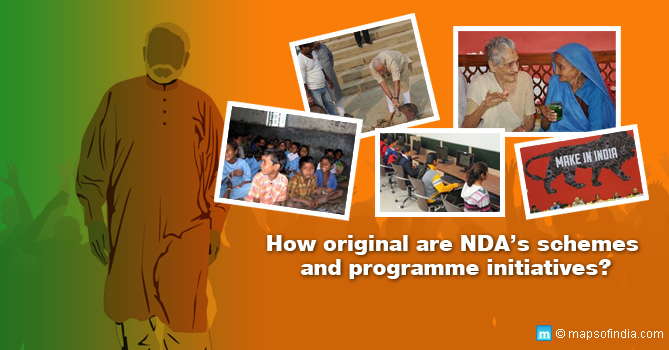There is no easy answer to this question. Congress party has been accusing Prime Minister Modi and his government of renaming, repackaging and re-launching various social security and infrastructure programmes that were launched during the UPA regime or earlier. So, is there any merit in this claim?
When we compare any scheme, programme or initiative of any government, there is a fair chance that there would be some form of similarity or overlapping between schemes or programmes of different governments. The difference mostly would lie in scale of fund deployment, target, size and spread of beneficiaries, and the efficiency of execution.
Too often, political parties squabble over claiming credit on being the first to initiate a programme. While that may well be the case, it is not the originality for which a government is remembered but on the parameters stated above. Therefore, if programmes of respective governments are to be factually compared, it must be on the basis of the parameters mentioned above and not really on the originality of the idea.
Take the NDA government under PM Modi launching the Digital India campaign. Without doubt it is an ambitious programme that will catalyze and catapult the Indian economy in the 21st century. That is an imperative and a necessity, and is original in its scope and ambition. However, to claim that this was the first in technology initiative would not stand true.
India’s IT revolution actually dates back to the policy decision taken during Prime Minister Indira Gandhi regime in 1984, just before her tragic death. This was launched and implemented by Rajiv Gandhi and was the first real step towards what later became an IT revolution in India.
For the first time, permission to export software through a satellite link, led to Texas Instruments to open its first centre in India. This was followed by several initiatives like establishing rural telephone exchanges, software technology parks etc, that ushered in an ecosystem on which the subsequent decades built upon, and today India is credited with having a cutting edge IT industry that can only get better. But it is unfair to compare any technology-based initiative like Digital India to any previous initiative, as all were during different eras, with different goals and on different technology platforms.
Insurance and Social Security schemes
Congress party has claimed that the present government had repackaged schemes like Rajiv Gandhi Shilpi Swasthya Beema Yojana (RGSSBY), Rashtriya Swasthya Beema Yojana (RSBY), Aam Aadmi Beema Yojana (AABY) and has reeled out statistics on the extent of success of the scheme. Now, any insurance or social security scheme would most likely not be unique in concept but different, based on the earlier mentioned parameters.
PM Modi has launched several schemes which include Pradhan Mantri Jeevan Jyoti Beema Yojana (PMJJBY), Pradhan Mantri Suraksha Bima Yojana (PMSBY) and Atal Pension Yojana (APY).
His government has launched a health scheme for ‘all’ at Rs 700-800 per year that provides a cover of Rs 50,000/- and can be availed by anyone between 18 and 40 years of age.
Now compare this with say the Rajiv Gandhi Jeevandayee Arogya Yojana that offers ‘free’ medical health insurance cover up to Rs 1,50,000/- per family of those Below Poverty Line (BPL) and certain Above Poverty Line (APL). The scheme offers access to hospitalisation and 971 different surgeries, under 30 medical specialisations.
Here again, it would not be fair to compare schemes as each has a different target beneficiary; the size and scope also varies and thus, merely claiming to be the first to launch, serves little purpose.
One can debate if a programme initiative should be carried forward or not by a new government but to claim uniqueness or being the first should bear little significance. The success of the programme lies in the extent of programme objective being met rather than who launched it and when.
UPA’s Nirmal Bharat Abhiyan versus NDA’s Swachh Bharat Mission
This is indeed a case of naming and renaming of an earlier scheme that owes its origin to the ‘Total Sanitation Campaign’ that was initiated under the Atal Bihari Vajpayee government in 1999. The objective was to eradicate the practice of open defecation by building toilets in homes. The success of the programme was carried forward during the UPA I regime and given the success of the programme, it was renamed as Nirmal Bharat Abhiyan in 2012.
The programme was once again renamed when the present NDA regime took office and is today called Swachh Bharat Mission (SBM). SBM has broadened the mission to include clean drinking water along with the earlier objective of discouraging open defecation by encouraging people to build toilets in their homes.
In this case, the Congress cannot claim credit for originality nor can they blame the present NDA government of resorting to name changing, as they too changed the mission name in 2012.
UPA’s JNNURM versus NDA’s AMRUT
Jawahar Lal Nehru National Urban Renewal Mission (JNNURM) was launched during UPA I regime in 2005, while Atal Mission for Rejuvenation and Urban Transformation (AMRUT) was launched in April 2015 by the present NDA government. AMRUT is basically an improved version of JNNURM that addresses several flaws that held back the programme’s success and has widened its objective, size and scale. JNNURM targeted 63 cities, while AMRUT will cover 500 cities with a population of over one lakh. JNNURM was largely centre driven with states slow to come on board and implement, AMRUT decentralizes the implementation powers to states and gives them the responsibility to monitor the project.
Here again, Congress can’t really claim credit as the two programmes differ vastly in plan, scope, implementation and monitoring. The NDA has improved on the earlier initiative and has scaled up the objective significantly.
UPA’s Rajiv Gandhi Grameen Vidyutikaran Yojana (RGGVY) versus NDA’s Deen Dayal Upadhyaya Gram Jyoti Yojana (DDUGJY)
RGGVY was launched under the UPA regime and aimed at extending rural electrification in India. The present NDA regime has replaced RGGVY with its own DDUGJY, which is again about extending the rural electrification programme on a wider scale and with higher funding. Rural electrification is an ongoing process for any government, therefore, no government can claim credit for the initiative. Renaming and re-launching a programme is the prerogative of any government in power.
Final sum up
Too much attention is focused by political parties in claiming credit for launching programmes but the fact remains that each regime’s performance will be judged by the success of each programme and good work will always be given recognition as in the case of Golden Quadrilateral Highway Project under Atal Bihari Vajpayee government, while the good work under MNREGA will always remain with UPA.
Programmes Launched by NDA Government
Atal Pension Yojana (APY)
MUDRA Bank Yojana
Pradhan Mantri Jeevan Jyoti Bima Yojana (PMJJBY)
Pradhan Mantri Suraksha Bima Yojana (PMSBY)
Sukanya Samriddhi Account
Pradhan Mantri Kaushal Vikas Yojana
Pradhan Mantri Krishi Sinchai Yojana
Pradhan Mantri Awas Yojana (PMAY)
One Rank One Pension Scheme
Seventh Pay Commission
Schemes of Ministry of Micro, Small and Medium Enterprises (MSME)
Garib Kalyan Yojnaye
Integrated Power Development Scheme (IPDS)
All Information about Digital India Programme
DigiLocker
eBasta – Features and Benefit for students
Atal Mission for Rejuvenation and Urban Transformation
Government to set up 300 rural clusters by 2020
Mahatma Gandhi National Rural Employment Guarantee Act (MGNREGA)
Beti Bachao, Beti Padhao Scheme
Pahal Scheme
Jan Dhan Yojana
Skill India
Modi’s Sagar Mala Project






